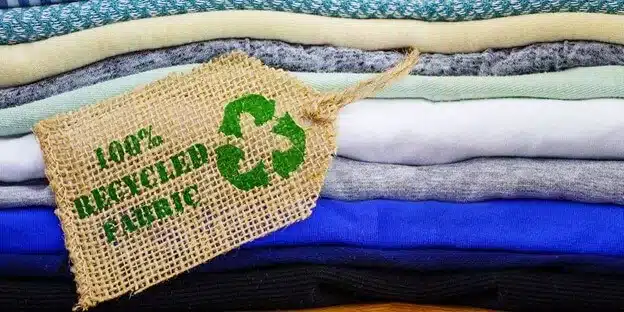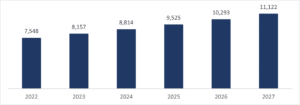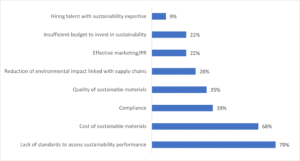The State of Sustainability in the Fashion Industry

Table of Contents
In today’s fashion landscape, sustainability has become a powerful force, compelling brands to reassess their operations and present an eco-conscious image. As consumer demand for ethically sourced products grows, fashion companies are recognizing the need to adopt concrete measures for responsible practices. From sourcing materials to manufacturing processes, a comprehensive approach to sustainability is emerging, aiming to address the industry’s environmental impact.
The fashion industry’s impact on global carbon dioxide emissions is substantial, accounting for 932 million metric tons, which is up to 10% of the total output. Additionally, it plays a significant role in generating one-fifth of the world’s annual plastic production, amounting to 300 million tons. These figures highlight the pressing and immediate requirement to adopt sustainable practices within the industry.
To ensure a prosperous and accountable future for fashion, a fundamental transformation towards sustainability becomes imperative. In our exploration of sustainable practices in the fashion industry, we touch upon the challenges it faces. To delve deeper into how innovative solutions, such as regulatory sandboxes, are shaping various industries, including fashion. This transformation should encompass environmentally and socially responsible approaches to sourcing materials, manufacturing processes, and ensuring fair working conditions and wages throughout the supply chain.
Embracing Sustainability: The Global Surge of Ethical Fashion
Amidst the thriving landscape of ethical fashion, the global fashion market is experiencing a notable transformation. As of 2022, sustainable clothing items have claimed a modest share of 4.3% in the market, increasing from 2.83% in 2017. This upward trend indicates a growing awareness and demand for eco-friendly fashion choices. Furthermore, the ethical fashion market has witnessed remarkable growth, achieving a substantial value of nearly USD 7.5 Bn in 2022, driven by a steady compounded annual growth rate (CAGR) of 6.5% since 2017.
Looking ahead, projections suggest that the ethical fashion market will continue to expand, with a projected value of USD 11.2 Bn by 2027, growing at a notable rate of 8.1%. Beyond 2027, the journey is expected to maintain its momentum with an estimated CAGR of 8.6%, ultimately reaching an impressive value of USD 16.8 Bn by 2032.

The market growth is driven by a surge in synthetic and regenerated materials, such as Tencel, a fabric made from sustainably sourced wood pulp, and innovative options like Pinatex, which is derived from pineapple fibers. These materials collectively contribute to this expansion with an impressive 50.9% share. Additionally, the organic segment is projected to exhibit high growth at a rate of 16.4% CAGR. Animal cruelty-free brands currently dominate the market, holding a 43.3% share, while eco-friendly brands are expected to grow rapidly at a rate of 10.6% between 2022 and 2027.
In terms of regional dynamics, the Asia Pacific region takes the lead in the ethical fashion market, holding a significant 33.0% market share in 2022. Eastern Europe and South America are poised to emerge as the fastest-growing regions, with projected CAGRs of 12.5% and 10.3%, respectively.
Driving Forces and Challenges: The Ethical Fashion Market’s Journey Towards a Responsible Future
The significant growth of the ethical fashion market is driven by several key factors. The rise of emerging markets, increased foreign direct investments, and a growing focus on sustainable fashion by consumers have all played a pivotal role in this expansion. Despite challenges, such as the high costs and the impact of reduced free trade, the global apparel market is increasingly aligning with ethical fashion, converging towards a shared vision of a responsible and eco-conscious future.
One of the primary drivers behind this growth is the increasing global population. As the world’s population continues to grow, the demand for innovative and sustainable fabrics used in apparel, automobiles, and home furnishings products is on the rise. This presents significant opportunities for companies in the ethical fashion market to capitalize on the growing demand for efficient and durable fabrics.
However, the path to sustainability in the fashion industry comes with challenges. Integrating sustainable practices requires substantial investments, posing financial hurdles for businesses. Additionally, the complexities of reduced free trade need to be carefully managed to balance sustainability with global commerce.
The war in Ukraine is also significantly influencing the industry, resulting in inflation and disruptions that have compelled companies to suspend or halt operations in the affected regions. Consequently, Consequently, well-known clothing brands such as H&M and Zara have been compelled to close stores and suspend their activities in Russia, leading to adverse effects on the market’s growth.

Emerging Trends: Recycling, Upcycling, and Storytelling for a Greener Future
Amidst these challenges, there are several noteworthy trends that are shaping the ethical fashion industry. Recycling and upcycling have emerged as crucial practices to reduce waste. By recycling materials and upcycling discarded items, companies can significantly reduce their carbon footprint and minimize waste in the manufacturing process. For example, Rubymoon, a UK-based swimwear and activewear company, creates its products using fishing nets and plastic bottles from the ocean. Similarly, India-based social enterprise EcoKaari upcycles waste plastic into handcrafted fabrics, which are then used to make fashion accessories and utility items.
Another trend gaining traction in the market is storytelling and customer education. Brands are increasingly transparent about their production and design processes, highlighting their commitment to ethics and sustainability. By highlighting good practices in sourcing and production, companies can build credibility and trust with consumers who prioritize eco-friendly choices. For example, RSPR, a Doha-based clothing manufacturer, educates consumers on eco-friendly and ethical fashion, emphasizing their use of recycled plastic bottles to create soft, antimicrobial garments.
Leading Brands Driving Global Awareness
In response to the growing demand for sustainability in the fashion industry, brands worldwide have embraced eco-friendly practices, highlighting the power of global awareness in promoting sustainable development. Companies that prioritize true sustainability are reaping positive results in their communities.
Innovations in Sustainable Fashion
Levi’s excels as a prime example in this area with its impactful ‘Buy Better, Wear Longer’ campaign.” This global initiative raised awareness among consumers, urging them to make conscious apparel choices while emphasizing Levi’s commitment to producing durable clothing that lasts for generations. By collaborating with influencers like Emma Chamberlain, Furthermore, Levi’s successfully engaged with the younger generation and amplified their sustainability message through media reach.
Patagonia: A Model of Sustainability
Another exemplar of sustainable practices in the industry is Patagonia. Moreover, Patagonia not only employs sustainable materials in its clothing but also empowers customers to repair their clothes instead of buying new ones. The company allows customers to return clothes in good condition for new merchandise credits. The pieces are then cleaned, repaired, and sold on the company’s Worn Wear platform. By encouraging customers to value and maintain their clothing, Patagonia fosters a culture of sustainability and responsible consumption.
Overcoming Barriers to Sustainability
Conversely, lack of access to data, metrics, and transparency around sustainability initiatives has been the primary barrier hindering change, often leaving retailers uncertain about the cost versus benefits. To embed sustainable practices seamlessly into their value chains, retailers require appropriate tools and measures, making sustainability a standard part of their business operations.
Sustainable Materials and Packaging
As companies prioritize reducing their carbon footprint, they are employing various approaches. Many are opting for recycled/sustainable raw materials and packaging, demonstrating their commitment to environmental responsibility in both upstream and downstream aspects. However, while 56% of companies are using more recycled/sustainable raw materials and 46% are using sustainable packaging, there remains a significant distance to cover before the industry fully embraces these vital elements as an integral part of their operations.
The Future of Ethical Fashion
The fashion industry is experiencing a profound shift towards sustainability, driven by increasing consumer demand for eco-conscious choices. With the industry’s significant environmental impact, urgent and concrete measures are essential for a responsible future. Fortunately, the rise of ethical fashion has been remarkable, displaying a steady growth trend and a promising market value. Additionally, Recycling, upcycling, and storytelling are emerging as key trends, fostering a greener future. Leading brands, like Levi’s and Patagonia, are setting a positive example by prioritizing sustainability and promoting responsible consumption.
As we move forward, it is crucial for the fashion industry to embrace sustainable practices wholeheartedly, making them an integral part of their operations and ensuring a thriving, eco-friendly future for all.
Sources:
https://issuu.com/sourcingjournalevents/docs/fashion-in-focus-survey-report-2022?fr=sMmJmMjQ5OTEwOTk
https://www.mckinsey.com/industries/retail/our-insights/state-of-fashion
https://www.statista.com/statistics/1360324/fashion-company-carbon-footprint-reduction-actions/
https://www.factmr.com/report/sustainable-apparel-market
https://www.thebusinessresearchcompany.com/report/ethical-fashion-market
https://www.statista.com/statistics/1305641/ethical-fashion-market-value/
https://www.researchandmarkets.com/report/sustainable-fashion
https://blog.gitnux.com/sustainable-fashion-industry-statistics/
https://www.forbes.com/sites/forbescommunicationscouncil/2023/sustainability-in-the-fashion-industry